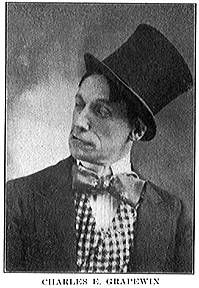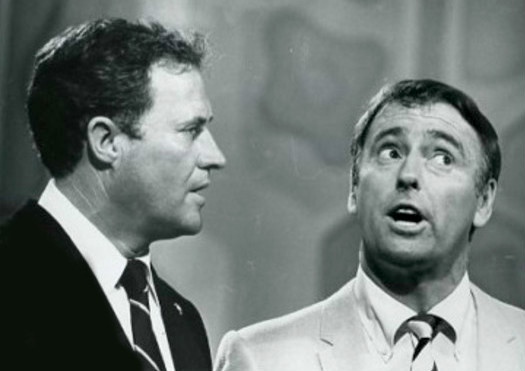|
Blackout Gag
A blackout gag is a kind of joke in broad, rapid-fire slapstick comedy. The term is derived from burlesque and vaudeville, when the lights were quickly turned off after the punchline of a joke to accentuate it and encourage audience laughter. It may use a shock value to define the joke, and may not be initially noticeable to all viewers if it is a very fast joke. "A blackout gag and a moment's silence provide the transition to the next scene" It is distinguished from an iris shot, frequently used in the silent film era, where a black circle closes to end a scene. The term blackout gag can also apply to fast-paced television or film comedy, such as ''Rowan & Martin's Laugh-In ''Rowan & Martin's Laugh-In'' (often simply referred to as ''Laugh-In'') is an American sketch comedy television program that ran for six seasons from January 22, 1968, to July 23, 1973, on the NBC television network. The show, hosted by comed ...'', where there may not literally be a blackout, but a q ... [...More Info...] [...Related Items...] OR: [Wikipedia] [Google] [Baidu] |
Slapstick
Slapstick is a style of humor involving exaggerated physical activity that exceeds the boundaries of normal physical comedy. Slapstick may involve both intentional violence and violence by mishap, often resulting from inept use of props such as saws and ladders. The term arises from a device developed for use in the broad, physical comedy style known as ''commedia dell'arte'' in 16th-century Italy. The "Clapper (musical instrument), slap stick" consists of two thin slats of wood, which makes a "slap" when striking another actor, with little force needed to make a loud—and comical—sound. The physical slap stick remains a key component of the plot in the traditional and popular Punch and Judy puppet show. More contemporary examples of slapstick humor include ''The Three Stooges'', ''The Naked Gun'' and ''Mr. Bean (character), Mr. Bean''. Origins The name "slapstick" originates from the Italian ''batacchio'' or ''bataccio''—called the "Clapper (musical instrument), slap sti ... [...More Info...] [...Related Items...] OR: [Wikipedia] [Google] [Baidu] |
Burlesque
A burlesque is a literary, dramatic or musical work intended to cause laughter by caricaturing the manner or spirit of serious works, or by ludicrous treatment of their subjects."Burlesque" ''Oxford English Dictionary'', , accessed 16 February 2011 The word is loaned from French and derives from the Italian ', which, in turn, is derived from the Italian ' – a joke, ridicule or mockery. Burlesque overlaps with , and [...More Info...] [...Related Items...] OR: [Wikipedia] [Google] [Baidu] |
Vaudeville
Vaudeville (; ) is a theatrical genre of variety entertainment which began in France in the middle of the 19th century. A ''vaudeville'' was originally a comedy without psychological or moral intentions, based on a comical situation: a dramatic composition or light poetry, interspersed with songs and dances. Vaudeville became popular in the United States and Canada from the early 1880s until the early 1930s, while changing over time. In some ways analogous to music hall from Victorian Britain, a typical North American vaudeville performance was made up of a series of separate, unrelated acts grouped together on a common bill. Types of acts have included popular and classical musicians, singers, dancers, comedians, trained animals, magicians, ventriloquists, strongmen, female and male impersonators, acrobats, clowns, illustrated songs, jugglers, one-act plays or scenes from plays, athletes, lecturing celebrities, minstrels, and films. A vaudeville performer ... [...More Info...] [...Related Items...] OR: [Wikipedia] [Google] [Baidu] |
Iris Shot
An iris shot is a technique used in silent film and sometimes television to emphasize a detail of a scene above all others, more commonly to end or open a scene. The film camera's iris is slowly closed or opened, so that what is visible on film appears in a decreasing or increasing circle, surrounded by black. The iris shot used at the start of a scene is an iris in and an iris out is used at the end of a film/episode or a particular scene. ''Iris in'' is also used after a previous ''iris out'' to allow different episodes or scenes to begin in a more natural way. Iris shots are also used to put emphasis on a particular aspect of film, usually something of importance. After the silent film era, the technique became less used, and has mainly been used only for ironic or comedic effect. An example of non-ironic iris shot as part of the grammar of film is found in "Life Lessons", the Martin Scorsese-directed segment of ''New York Stories''. Non-silent era slapstick and animation—such ... [...More Info...] [...Related Items...] OR: [Wikipedia] [Google] [Baidu] |
Silent Film
A silent film is a film without synchronized recorded sound (or more generally, no audible dialogue). Though silent films convey narrative and emotion visually, various plot elements (such as a setting or era) or key lines of dialogue may, when necessary, be conveyed by the use of inter- title cards. The term "silent film" is something of a misnomer, as these films were almost always accompanied by live sounds. During the silent era, which existed from the mid-1890s to the late 1920s, a pianist, theater organist—or even, in larger cities, an orchestra—would play music to accompany the films. Pianists and organists would play either from sheet music, or improvisation. Sometimes a person would even narrate the inter-title cards for the audience. Though at the time the technology to synchronize sound with the film did not exist, music was seen as an essential part of the viewing experience. "Silent film" is typically used as a historical term to describe an era of cinema p ... [...More Info...] [...Related Items...] OR: [Wikipedia] [Google] [Baidu] |
Rowan & Martin's Laugh-In
''Rowan & Martin's Laugh-In'' (often simply referred to as ''Laugh-In'') is an American sketch comedy television program that ran for six seasons from January 22, 1968, to July 23, 1973, on the NBC television network. The show, hosted by comedians Dan Rowan and Dick Martin, originally aired as a one-time special on September 9, 1967, and was such a success that it was brought back as a series, replacing ''The Man from U.N.C.L.E.'' on Mondays at 8 pm (ET). It quickly became the most popular television show in the United States. The title of the show was a play on the 1960s Hippie culture "love-ins" or the Counterculture "Central Park be-ins, be-ins", terms derived from the "sit-ins" common in protests associated with Civil rights movement, civil rights and List of protests against the Vietnam War, antiwar demonstrations of the time. In the pilot episode, Dan Rowan explained the show's approach: "Good evening, ladies and gentlemen, and welcome to television's first Laugh-In. Now ... [...More Info...] [...Related Items...] OR: [Wikipedia] [Google] [Baidu] |
One-line Joke
A one-liner is a joke that is delivered in a single line. A good one-liner is said to be pithy – concise and meaningful. Comedians and actors use this comedic method as part of their performance, and many fictional characters are also known to deliver one-liners, including James Bond, who often makes pithy and laconic quips after disposing of a villain. Examples * "Never read a pop-up book about giraffes." ( Sean Lock) * "Throwing acid is wrong. In some people's eyes." ( Jimmy Carr) * "My girlfriend makes me want to be a better person - so I can get a better girlfriend." ( Anthony Jeselnik) * "Cricket. No matter who wins, both teams, and all the fans, are losers." ( Frankie Boyle) * "An escalator cannot break, it can only become stairs." ( Mitch Hedberg) * "My movies were the kind they show in prisons and airplanes, because nobody can leave." (Burt Reynolds) * "I'm on a whiskey diet… I've lost three days already." ( Tommy Cooper) * "I have nothing to declare except my genius ... [...More Info...] [...Related Items...] OR: [Wikipedia] [Google] [Baidu] |
John Wiley & Sons
John Wiley & Sons, Inc., commonly known as Wiley (), is an American Multinational corporation, multinational Publishing, publishing company that focuses on academic publishing and instructional materials. The company was founded in 1807 and produces books, Academic journal, journals, and encyclopedias, in print and electronically, as well as online products and services, training materials, and educational materials for undergraduate, graduate, and continuing education students. History The company was established in 1807 when Charles Wiley opened a print shop in Manhattan. The company was the publisher of 19th century American literary figures like James Fenimore Cooper, Washington Irving, Herman Melville, and Edgar Allan Poe, as well as of legal, religious, and other non-fiction titles. The firm took its current name in 1865. Wiley later shifted its focus to scientific, Technology, technical, and engineering subject areas, abandoning its literary interests. Wiley's son Joh ... [...More Info...] [...Related Items...] OR: [Wikipedia] [Google] [Baidu] |
Film And Video Terminology
A film, also known as a movie or motion picture, is a work of visual art that simulates experiences and otherwise communicates ideas, stories, perceptions, emotions, or atmosphere through the use of moving images that are generally, since the 1930s, synchronized with sound and (less commonly) other sensory stimulations. Etymology and alternative terms The name "film" originally referred to the thin layer of photochemical emulsion on the celluloid strip that used to be the actual medium for recording and displaying motion pictures. Many other terms exist for an individual motion-picture, including "picture", "picture show", "moving picture", "photoplay", and "flick". The most common term in the United States is "movie", while in Europe, "film" is preferred. Archaic terms include "animated pictures" and "animated photography". "Flick" is, in general a slang term, first recorded in 1926. It originates in the verb flicker, owing to the flickering appearance of early films ... [...More Info...] [...Related Items...] OR: [Wikipedia] [Google] [Baidu] |
Comedy
Comedy is a genre of dramatic works intended to be humorous or amusing by inducing laughter, especially in theatre, film, stand-up comedy, television, radio, books, or any other entertainment medium. Origins Comedy originated in ancient Greece: in Athenian democracy, the public opinion of voters was influenced by political satire performed by comic poets in Ancient Greek theatre, theaters. The theatrical genre of Greek comedy can be described as a dramatic performance pitting two groups, ages, genders, or societies against each other in an amusing ''agon'' or conflict. Northrop Frye depicted these two opposing sides as a "Society of Youth" and a "Society of the Old". A revised view characterizes the essential agon of comedy as a struggle between a relatively powerless youth and the societal conventions posing obstacles to his hopes. In this struggle, the youth then becomes constrained by his lack of social authority, and is left with little choice but to resort to ruses which e ... [...More Info...] [...Related Items...] OR: [Wikipedia] [Google] [Baidu] |






